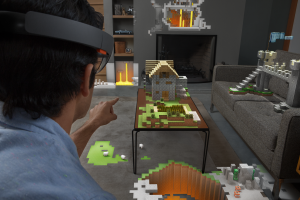 Microsoft introduced its HoloLens at Build 2015 to much excitement and fanfare, but it’s still far too early to tell when the augmented reality hardware and the Windows Holographic platform needed to run it will be a reality.
Microsoft introduced its HoloLens at Build 2015 to much excitement and fanfare, but it’s still far too early to tell when the augmented reality hardware and the Windows Holographic platform needed to run it will be a reality.
Developers professed great interest in working with the augmented reality platform to create their own applications. But they want to get their hands on a development kit now. The Microsoft HoloLens website reveals no timetable on its release. All it says is, “We’re working hard to release development tools. In the meantime, you can start by building Windows universal apps and ramping up on Unity.”
By Windows universal apps they must mean Windows 10 universal apps. A further dive into the HoloLens site reveals another little tidbit:
Every device running Windows 10 uses a common, unified core. So everything you learn about developing universal apps for Windows 10 will help you get ready to develop for Microsoft HoloLens.
To get started, register for the Windows Insider Program and install the Windows 10 Technical Preview.
On Tom’s Guide, Avram Piltch explains why you should care, though I think he’s being very optimistic:
“It could take a few years to go mainstream, but augmented reality is in your future…. In the near future, the virtual objects you use will be apps, and your home will be the UI. AR will touch every aspect of modern life. Elementary school students will learn about dinosaurs by interacting with virtual exhibits while plumbers look at diagrams projected on top of your pipes.”
I’m not sure that this author has ever sat through a school board budget meeting. Interactive whiteboards, which have been all the rage in many school circles, aren’t that new to the tech world. But many schools still rely on old-fashioned whiteboards and even chalkboards. It’s all about the money. And the biggest capital projects are to either build new schools, or renovate existing buildings. Even buying one HoloLens for each classroom might be prohibitively expensive for a school system. Not every student, as hard as it is to believe for some people, even has a computer.
In the business world, do you replace all of your existing computers with the HoloLens in the future? Or do you now have to buy two computers? That could easily break an IT department’s budget.
I’m more of a mind on this in line with what nickajderian pointed out on a blog on SoftwareMechanik:
“It’s going to be eye-wateringly expensive piece of kit: there are many sensors and much processing required, and battery life is going to be minutes.”
The HoloLens certainly seems ideal for any industry or job that involves in any kind of design, from architecture to landscape to product design. An entire organization wouldn’t necessarily need to be supplied with the HoloLens. Restricting it to the design team and the C-Suite probably would be all that’s needed.
And as James Nunn said on the day of Microsoft’s introduction of the HoloLens, the device is being pushed as a more business focused competitor to Facebook’s Oculus Rift. Other groundbreaking uses include medical training for medical students, who can learn procedures without having to pick up a scalpel.
Even the military has found use for augmented reality, though it’s not with the HoloLens. Just last week U.S. Marines turned a Virginia golf course into a simulated battlefield, with tanks, mortar fire and smoke.
U.S. Marines on Thursday were able to turn a golf course in Virginia into a simulated battlefield, complete with tanks, mortar fire and smoke.
Computerworld’s Sharon Gaudin reported that the augmented reality glasses superimpose images of a battlefield situation onto the golf course, allowing Marines to practice in a battle situation – but without the expense of setting up a fake battlefield. SA Photonics manufactures the glasses the Marines used for just the first time.
That should be evidence enough that the HoloLens should shine in game development. Since other vendors will be able to work with Windows Holographic and the APIs for the HoloLens – and create competing hardware while still using that platform – I can envision many gamers immersing themselves in augmented reality. Somehow they’ll figure out a way to “destroy” augmented reality versions of actual landscapes and landmarks out in the real world. Though I hope they don’t come up with Grand Theft Auto HoloLens edition that has gamers playing in real urban landscapes.
Izenda blends seamlessly into your business process, application strategy and your interface. If you leverage .NET and HTML5 in your development efforts, Izenda is your reporting and business intelligence solution.
Follow Izenda on social media for the latest on technology and business intelligence:
![]()
![]()
![]()

